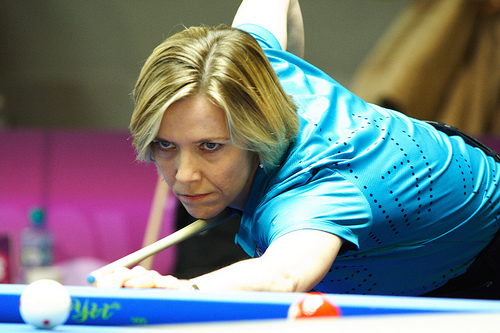For the newer players:
I've been hacking away at narrowing down my stroke for the past 4 years. This is not an old story; a lot of other players do the same thing. I've also been trying to keep a memory of my progress. Professional coaches really help, but unfortunately they can't feel the same things you feel, and therefore can only guide you (though can guide you very well).
From all of the years of trying everything in and out of the book, I've definitely found the biggest distinction between black and white in my pool career. It is the amount of height you need to put into your elbow in your stroking arm. It should be much higher than is initially comfortable.
I'm confident that most inaccurate shots resulting from poor stroke technique is the result of the body recruiting motion from the rotator cuff (or shoulder). Ive noticed that even a slight twitch of the shoulder before impact drastically misaligns the tip position. I've discovered that there is actually a certain point where by raising by elbow high enough, by body no longer feels the subconscious urge to want to move my rotator cuff. This point, I remember, did NOT feel natural the first 5 minutes I discovered it, but got used to it very quickly when it realized that it was more accurate than anything else it every tried. From this, you don't need much forward-going energy at all, the cue takes care of all of the power itself. After a while you start losing the habit of throwing your arm into the shot.
Now, the humbling thing is that this advice has been told to me over and over again, and I've tried and tried to accomplish it, with and without advanced players watching me. The problem is that the advanced players don't have nerves in MY muscle and they can't give me advice on MY physiology. I had to stretch my limb and muscle to an unfamiliar position to discover it. Before this I still rotated my shoulder into the shot, but it was such a tiny amount that I could't even notice it when I watched my own video tapes, let alone my coach.
Now when I watch the AccuStats videos, when I watch other great players play, I can clearly see that this is how they stroke, or at least, its the foundation of it. Any shoulder movement by them is just recovery of the cue after the stroke has happened.
I am hoping that by sharing my progress in this way it will encourage those still hunting for their stroke that there is actually a bright light at the end of the tunnel, and that all of the advice given to them will eventually converge.
I've been hacking away at narrowing down my stroke for the past 4 years. This is not an old story; a lot of other players do the same thing. I've also been trying to keep a memory of my progress. Professional coaches really help, but unfortunately they can't feel the same things you feel, and therefore can only guide you (though can guide you very well).
From all of the years of trying everything in and out of the book, I've definitely found the biggest distinction between black and white in my pool career. It is the amount of height you need to put into your elbow in your stroking arm. It should be much higher than is initially comfortable.
I'm confident that most inaccurate shots resulting from poor stroke technique is the result of the body recruiting motion from the rotator cuff (or shoulder). Ive noticed that even a slight twitch of the shoulder before impact drastically misaligns the tip position. I've discovered that there is actually a certain point where by raising by elbow high enough, by body no longer feels the subconscious urge to want to move my rotator cuff. This point, I remember, did NOT feel natural the first 5 minutes I discovered it, but got used to it very quickly when it realized that it was more accurate than anything else it every tried. From this, you don't need much forward-going energy at all, the cue takes care of all of the power itself. After a while you start losing the habit of throwing your arm into the shot.
Now, the humbling thing is that this advice has been told to me over and over again, and I've tried and tried to accomplish it, with and without advanced players watching me. The problem is that the advanced players don't have nerves in MY muscle and they can't give me advice on MY physiology. I had to stretch my limb and muscle to an unfamiliar position to discover it. Before this I still rotated my shoulder into the shot, but it was such a tiny amount that I could't even notice it when I watched my own video tapes, let alone my coach.
Now when I watch the AccuStats videos, when I watch other great players play, I can clearly see that this is how they stroke, or at least, its the foundation of it. Any shoulder movement by them is just recovery of the cue after the stroke has happened.
I am hoping that by sharing my progress in this way it will encourage those still hunting for their stroke that there is actually a bright light at the end of the tunnel, and that all of the advice given to them will eventually converge.
Last edited:

